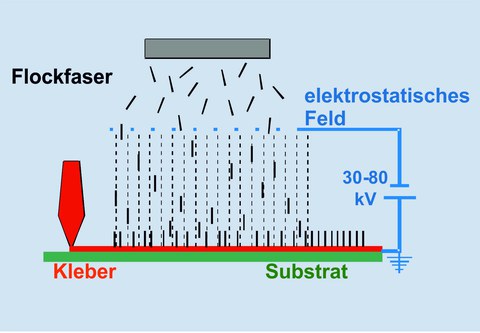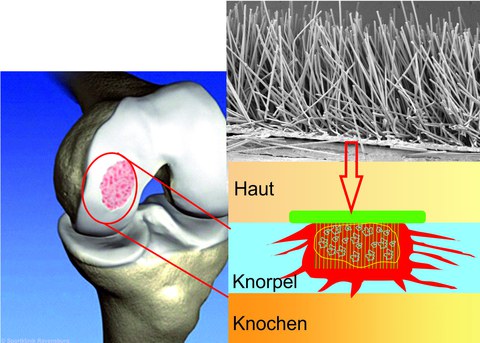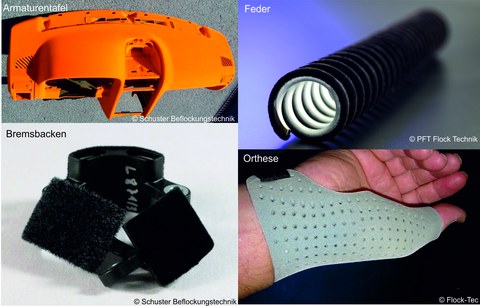Flocking

Working principle of electrostatic flocking technology
The possibilities offered by electrostatic flocking to give an object additional new properties are versatile. Almost any surface can be given a special finish by short fibers applied perpendicularly to it. This is not limited to improving the look of the surface or the carrier material (substrate), but can mean additional functional properties as well. Textile fibers (flock) are the main material used for flocking. These fibers are cut to a defined length by machines, and their surface is treated. This is usually necessary to ensure the flock offers sufficient electric conductivity and pourability for the respective application. Typical fiber materials used as flock include polyamide, viscose, and polyester. In flocking, the fibers are accelerated by an electric field and enclosed in an adhesive bed along the field lines arranged perpendicularly to the surface. The parallel alignment of the fibers on flocked products cause an optical and haptic similarity to velvet.
Depending on the used fiber length and fineness, flocked products can show different properties and fulfill the related tasks. Due to their positive characteristics, flocking is used in a wide variety of technical areas, including automotive and vehicular engineering for improvements to smooth running, window sliding properties, and noise reduction, or in construction as insulation layers against heat, cold, and sound.

Joint cartilage: Defect and healing process with flocked scaffold
Another promising application area of electrostatic flocking is regenerative medicine. Using flock structures as cell carrier structures (so-called scaffolds) offers the advantage of an excellent surface/volume ratio and large area for cell adhesion. The almost parallel arrangement of the fibers provides the cells with an open-pored structure with oriented and interconnected pores, i.e. inter-fiber spaces, for cell migration. For this, any biomaterial can be used as substrates, adhesives, and flocking fibers. The result is very dense and homogeneous surface characterized by a high pressure resistance at high porosity. The cell carriers are very suitable for the colonization with cells for hard and soft tissue regeneration.
Contact person:
 © Mirko Krziwon
© Mirko Krziwon
Mr Dr. Michael Wöltje
Research Group Leader Biomaterials and Medical Technology
Send encrypted email via the SecureMail portal (for TUD external users only).
Visiting address:
Breitscheidstr. 78, House D, Room 1.1.13
01237 Dresden

